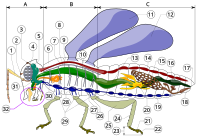
Photo from wikipedia
Introduction Trunk muscles play a role in maintaining postural stability and performing goal-directed voluntary movements in activities of daily living. Evidence has shown that the primary motor cortex (M1) is… Click to show full abstract
Introduction Trunk muscles play a role in maintaining postural stability and performing goal-directed voluntary movements in activities of daily living. Evidence has shown that the primary motor cortex (M1) is involved in modulation of postural control and voluntary movements of the trunk. However, it remains unknown whether the neural circuits within the M1 were recruited to the same extent between a postural task and a goal-directed voluntary task. Methods To address this, we examined latencies and amplitudes of motor evoked potentials (MEPs) of the erector spinae (ES) with transcranial magnetic stimulation (TMS) figure-of-eight coil oriented to induce latero-medial (LM), posterior-anterior (PA), and anterior-posterior (AP) currents in the M1 in twenty healthy participants during a dynamic shoulder flexion (DSF) task, a postural task requiring anticipatory postural adjustments (APAs), and during a static trunk extension (STE) task, a voluntary task without involvement of APAs. Results We found that differences in the AP-LM latency of ES MEP were longer compared with the PA-LM latency in both tasks. Corticospinal excitability was overall greater during the DSF task than during the STE task irrespective of the coil orientation. Discussion Our findings suggest that while the same neural circuits in the M1 were recruited to modulate both postural and voluntary control of the trunk, the contribution was greater to the postural task than the voluntary task, possibly due to the requirement of APAs in the task.
Journal Title: Frontiers in Human Neuroscience
Year Published: 2023
Link to full text (if available)
Share on Social Media: Sign Up to like & get
recommendations!